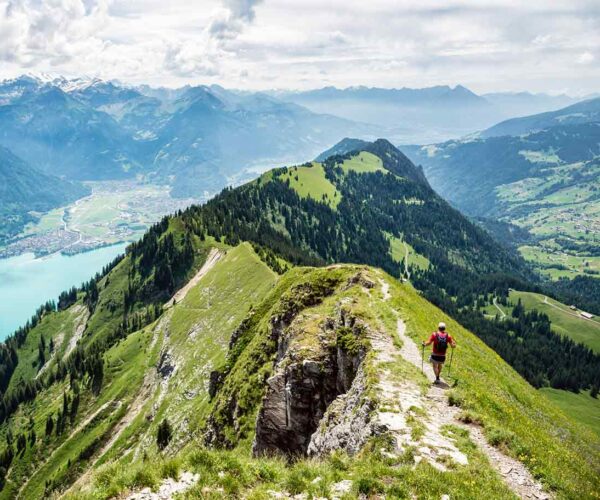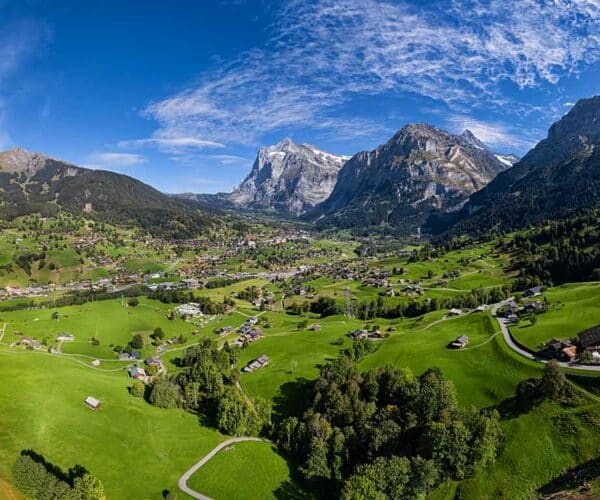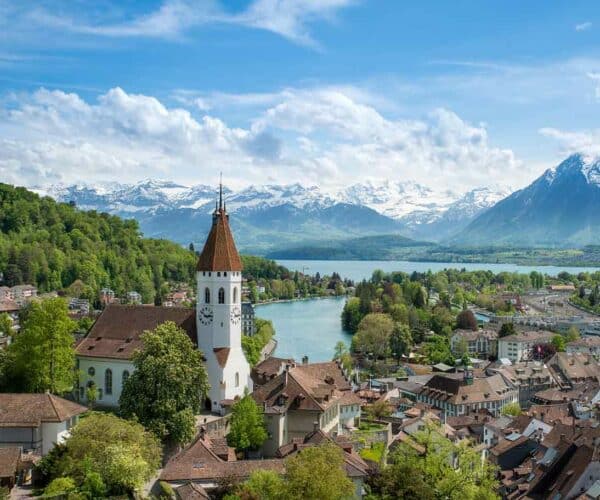Imagine a place where snow-capped mountains touch the sky, crystal-clear lakes reflect the peaks, and charming Swiss villages are sprinkled across lush valleys. Let’s explore the Bernese Oberland, a hiker’s paradise nestled in the heart of Switzerland.
The Bernese Oberland, also known as the Bernese Highlands is an area of mountains in Switzerland, known for its vast area of hiking trails.
If you’re a hiker looking for your next great adventure, look no further. Whether you’re after a leisurely stroll or a challenging trek, this guide has got you covered. So, lace up your boots, grab your backpack, and let’s dive into everything you need to know about hiking in Bernese Oberland!
Why Hike in the Bernese Oberland?

First things first—why should the Bernese Oberland be at the top of your hiking bucket list? Well, it’s all about the scenery. Picture this: towering peaks like the Eiger, Mönch, and Jungfrau standing proudly against the sky, with verdant valleys and shimmering lakes at their feet. Every step you take here is accompanied by breathtaking views that are sure to leave you in awe.
Cultural Richness
But it’s not just about the views. The Bernese Oberland is steeped in Swiss culture. As you hike, you’ll pass through charming villages where traditional wooden chalets are adorned with colourful flowers. Don’t be surprised if you stumble upon a local festival or hear the gentle clang of cowbells in the distance. It’s all part of the magic.
Accessibility
And the best part? It’s so easy to get here from the UK! Whether you’re flying in or taking the train, the Bernese Oberland is just a short hop away. Plus, once you’re in Switzerland, getting around is a breeze thanks to the country’s super-efficient transport system. But more on that later.
When to Hike in the Bernese Oberland
Best Hiking Seasons
Timing your visit is key to getting the most out of your hikes. Spring (April to June) is a lovely time to visit if you enjoy seeing the landscape come alive with blooming flowers and fresh greenery. Plus, the trails are less crowded, which is always a win.
Summer (July to September) is prime hiking season, with long days, warm weather, and all the trails fully accessible. This is when you’ll find the mountains at their most majestic, but do expect to share the trails with a few more fellow hikers.
Autumn (October) is the underdog of hiking seasons. The summer crowds have disappeared, and the landscape is awash with golden hues. It’s cooler, sure, but the crisp air and tranquillity more than make up for it.
Swiss weather can be a bit temperamental, so it’s always wise to check the forecast before setting out. In the mountains, it’s not unusual to experience all four seasons in one day, so pack layers and be prepared for anything!
If you’re not a fan of crowds, consider visiting during the shoulder seasons—late spring or early autumn. You’ll enjoy quieter trails, better accommodation deals, and a more relaxed pace. However, if you thrive on the buzz of peak season, summer is your time to shine!
Hikes in the Bernese Oberland

Now, let’s get to the fun part—the hikes! The Bernese Oberland has something for everyone, from gentle strolls to gruelling climbs.
Easy to Moderate Hikes
Lake Thun Panorama Trail
This one’s a gem for those who love a good view without too much effort. The trail winds along the shores of Lake Thun, offering panoramic views of the lake and mountains. Plus, you’ll pass through some lovely villages—perfect for a coffee stop.
Männlichen to Kleine Scheidegg
This is a classic hike that offers stunning views of the Eiger, Mönch, and Jungfrau. It’s mostly downhill, making it an easy hike, but the scenery is nothing short of spectacular. And the best part? There’s a cosy mountain restaurant waiting for you at the end.
Oeschinensee Hike
If tranquil lakes are your thing, this hike is for you. A short, easy walk brings you to Oeschinensee, a stunning turquoise lake surrounded by mountains. It’s the kind of place where you just want to sit and soak it all in.
Challenging Hikes
Eiger Trail
For those looking to test their mettle, the Eiger Trail is a must. This challenging hike takes you along the base of the Eiger’s North Face—a sheer wall of rock that’s both daunting and awe-inspiring. It’s tough, but the sense of achievement is well worth the effort.
Schynige Platte to First
This hike is a full day’s adventure and requires a good level of fitness. The trail offers some of the best views in the region, with panoramic vistas of the Eiger, Mönch, and Jungfrau. It’s a challenging trek, but the scenery is out of this world.
Faulhornweg
This is one for the seasoned hikers. The trail takes you to the summit of Faulhorn, where you’ll be rewarded with 360-degree views that will take your breath away (if the hike hasn’t already!). It’s long and strenuous, but oh-so-rewarding.
What is the Best Easy Hike in the Bernese Oberland?

Männlichen to Kleine Scheidegg
If you’re after a hike that’s easy on the legs but big on views, Männlichen to Kleine Scheidegg is the one for you. Why is it the best? Well, it’s a gentle downhill walk that’s perfect for all ages and fitness levels. But don’t let the ease fool you—the views are absolutely stunning. You’ll be walking with the iconic Eiger, Mönch, and Jungfrau as your backdrop. It’s like a postcard come to life.
What to Expect
The trail is well-marked and easy to follow. Along the way, you’ll pass through alpine meadows dotted with wildflowers, and you might even spot some marmots if you’re lucky! The walk ends at Kleine Scheidegg, where you can reward yourself with a hearty meal at one of the mountain restaurants.
Tips for the best experience
Start early to avoid the midday sun and the crowds. Bring a camera because you’ll want to capture those epic views. And don’t forget a light jacket—it can get chilly at higher altitudes.
What is the Most Challenging Hike in the Bernese Oberland?

Eiger Trail
For the thrill-seekers out there, the Eiger Trail is the ultimate challenge. Why is it the most challenging? Well, for starters, you’re hiking beneath the towering North Face of the Eiger—a sheer wall of rock that’s not for the faint-hearted. The trail is steep, rugged, and demands both physical and mental stamina. But the payoff? Absolutely unbeatable views and the bragging rights of having conquered one of Switzerland’s most famous trails.
What to Expect
The Eiger Trail is about 6 km long, with a significant elevation gain. It’s a tough climb, but the views are jaw-dropping. You’ll feel tiny as you walk beneath the Eiger’s imposing face. The terrain is rocky, and you’ll need to watch your step, especially on the steeper sections.
Preparation Tips
This isn’t a hike to be taken lightly. Make sure you’re physically prepared—this trail will test your endurance. Bring plenty of water, snacks, and good hiking boots. And always check the weather forecast before you set out. The Eiger is known for its sudden weather changes, and you don’t want to be caught unprepared.
How to get to the Bernese Oberland

Flying to Switzerland
Let’s start with the most straightforward option—flying. You’ve got a few airport choices when heading to Bernese Oberland. Zurich and Geneva are the main international gateways, with plenty of direct flights from major UK cities like London, Manchester, and Edinburgh. If you’re aiming for a more direct approach, you can also fly into Bern, which is closer to the action, though options might be more limited. Flight times are a breeze, usually around 1.5 to 2 hours. Before you know it, you’ll be sipping on Swiss hot chocolate!
Train Travel from the UK
If you’re more of a “journey is the destination” kind of traveller, then why not take the train? Start your adventure by hopping on the Eurostar from London to Paris, and then switch to a high-speed train that’ll whisk you into Switzerland. The bonus? You get to enjoy the scenic route, especially if you choose the GoldenPass Line, which offers jaw-dropping views as you wind through the Swiss countryside.
Driving from the UK
For those who fancy a bit of a road trip, driving is an option too. You can take the ferry or Eurotunnel to France and then drive through to Switzerland. It’s about 10-12 hours of driving, so maybe break it up with an overnight stay in France. Just think of the road trip playlist you can create!
Local Transportation in the Bernese Oberland
Once you’re in Bernese Oberland, getting around is a doddle. The Swiss rail network is top-notch—trains are punctual, clean, and the views from the window aren’t bad either! If you prefer to drive, renting a car is straightforward, but remember, Swiss roads can be a bit winding in the mountains. And for those planning to use public transport extensively, a Swiss Travel Pass is a great shout. It covers trains, buses, and even boats!
Practical Tips for Hiking in the Bernese Oberland

Gear Recommendations
Packing the right gear can make or break your hiking experience. Start with a good pair of hiking boots—they’ll be your best friend on the trails. Layering is key, so pack a mix of lightweight, moisture-wicking clothes, a warm jacket, and a waterproof layer. A sturdy backpack, a hat, sunglasses, and sunscreen are also must-haves. Don’t forget a map, compass, or GPS—getting lost is only fun in fairy tales!
Accommodation Options
Bernese Oberland offers a range of accommodation options to suit all budgets. For a traditional Swiss experience, consider staying in a mountain hut or guesthouse. If you prefer more comfort, there are plenty of hotels and chalets in towns like Grindelwald, Wengen, and Lauterbrunnen. And for those who like to keep it budget-friendly, there are some great hostels and campsites as well.
Transport Tips
Getting around Bernese Oberland is a breeze. The Swiss rail network is extensive and efficient, with trains running like clockwork. If you’re planning to visit multiple areas, consider getting a Swiss Travel Pass—it covers unlimited travel on trains, buses, and boats, and even gives you free or discounted entry to many attractions. If you prefer the freedom of a car, renting one is easy, but keep in mind that mountain roads can be narrow and winding.
Safety Considerations
Safety first! Always tell someone where you’re going and when you expect to return. Bring a fully charged phone and consider downloading a local emergency app. The weather can change rapidly in the mountains, so be prepared for anything. And remember, it’s always better to turn back if the conditions aren’t right.
Additional Activities for Hikers
Rest Days
Even the most enthusiastic hikers need a break sometimes. On your rest days, why not explore some of the local villages? Grindelwald, Wengen, and Lauterbrunnen are all charming spots to wander around. If you’re a fan of history and culture, visit the Jungfraujoch—the “Top of Europe”—for a stunning view and some fascinating exhibits.
Adventure Sports
Feeling adventurous? Bernese Oberland isn’t just for hiking—there’s a whole world of adventure sports waiting for you. Try paragliding over Interlaken for an unforgettable aerial view of the region, or head to the mountains for some climbing. And if you’re visiting in winter, skiing and snowboarding are a must!
Get Hiking & Trekking Insurance from SportsCover Direct
As demonstrated, there’s plenty of trails for all abilities for those venturing to the Bernese Oberland. One thing that you certainly shouldn’t forget is insurance, taking out suitable sports travel insurance can protect you in case things go wrong.
SportsCover Direct has been providing hiking and trekking insurance to intrepid explorers like you for decades. Our policy provides protection for unforeseen circumstances, including medical care, emergency rescue, repatriation, disruption to travel plans, or any loss, theft or damage that occurs to your luggage.
Cover starts from just a few pounds a month – a small consideration financially, but an important one ahead of a trip to remember. Learn more about our hiking policies in more detail today.
This blog has been created as general information and should not be taken as advice. Make sure you have the correct level of insurance for your requirements and always review policy documentation.